Did you know that nearly 90% of B2B buyers now start their purchase journey online? Online shopping has become essential for B2C and B2B businesses alike, creating an urgent need for powerful digital solutions. Therefore, choosing the right eCommerce platform is crucial for any eCommerce business aiming for sustainable growth—one that fits the current requirements and adapts as they expand.
Enterprise eCommerce solutions go beyond standard solutions, providing advanced tools to manage high traffic, complex operations, and seamless integrations with CRMs and other systems.
In this guide, we’ll break down the essentials to help you select the best enterprise eCommerce software for your business.
Key takeaways
- Selecting a solution that can scale with your business and support essential customizations is crucial for long-term growth.
- Ensuring the platform integrates seamlessly with CRM, ERP, and social media channels will help maintain consistent brand experiences and streamline data management.
- Considering the platform’s support options, ease of use, and overall costs can help you find a solution that aligns well with both your team’s capabilities and budget.
Why choosing the right platform matters
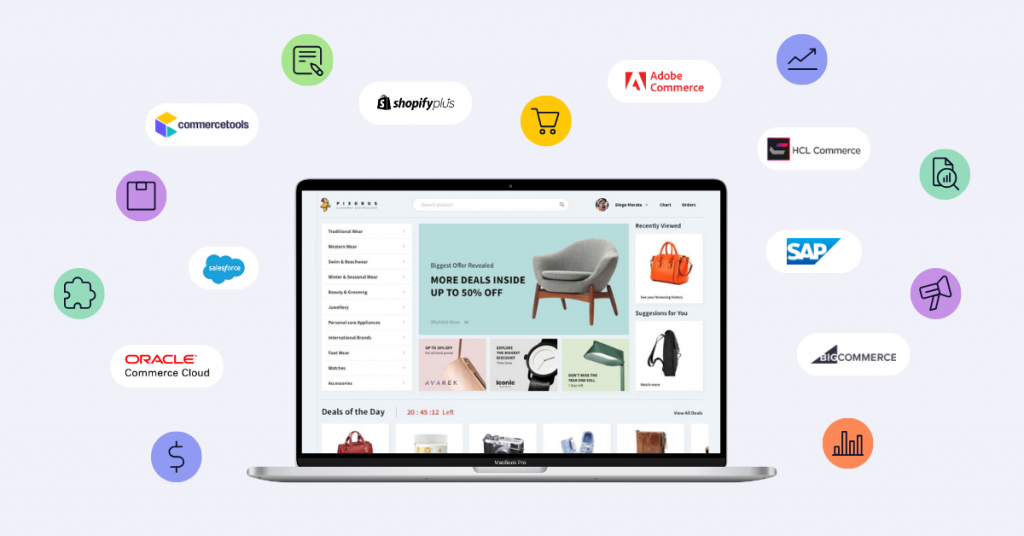
Choosing the right eCommerce platform is like setting a strong foundation for a skyscraper. It has to hold up under your current demands and be ready to grow and adapt along with your business. If the platform isn’t the right fit, here are some common issues you might face:
- If the platform can’t keep up as your business expands, migrating to another one later on can be a big, expensive hassle.
- Some platforms make it tough to customize or switch tools, leading to a vendor lock-in, which makes you overly dependent on their specific features and integrations.
- An outdated platform can hold you back from integrating with the latest tech, like new payment systems or marketing tools.
- Without the right level of customization and server power, your site might struggle with speed and reliability as traffic grows.
- If your site doesn’t integrate smoothly with key systems like CRM or inventory management, you can end up with data gaps and inefficient processes.
Choosing wisely from the start can prevent these roadblocks and ensure smoother scaling, better performance, and more effective operations. Let’s take a look at your options!
Main types of enterprise eCommerce solutions
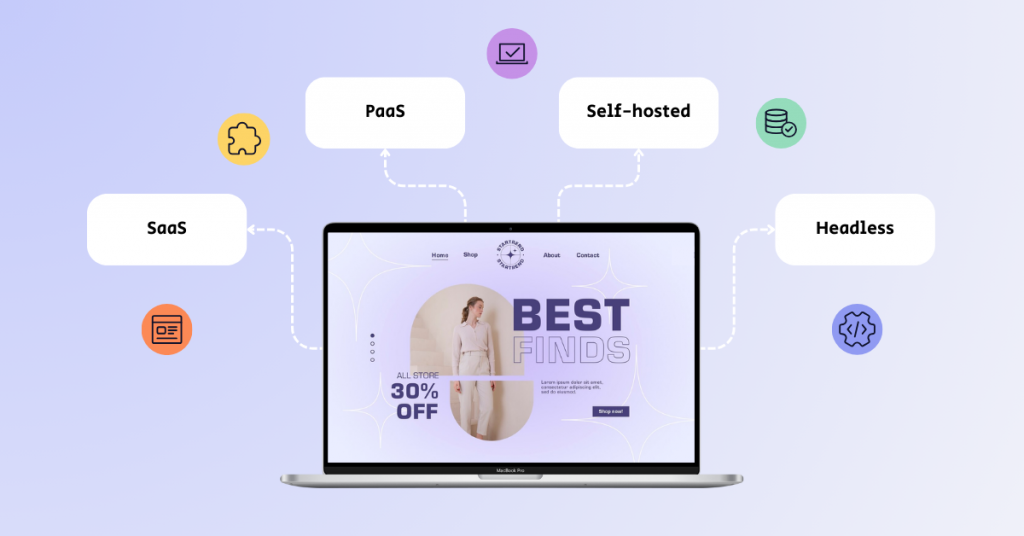
Software as a Service (SaaS) eCommerce platforms
SaaS platforms, like Shopify Plus and BigCommerce Enterprise, are fully hosted, with the provider managing hosting, updates, and security. Ideal for businesses seeking a fast, scalable solution with minimal technical requirements, SaaS platforms typically offer out-of-the-box solutions for businesses wanting a quick launch. However, they may be less flexible for deep customization needs when compared to self-hosted options.
Platform as a Service (PaaS) eCommerce solutions
PaaS options, such as Salesforce Commerce Cloud and Oracle Commerce Cloud, offer custom development capabilities on the provider’s infrastructure, allowing businesses to develop tailored applications while managing only parts of the platform. PaaS solutions cater to companies needing moderate customization without full self-hosting responsibilities, providing a blend of scalability and control. Additionally, these PaaS solutions provide essential tools for custom development and integration, facilitating inventory management, improved customer service, and keyword research.
Self-hosted or on-premise platforms
Self-hosted platforms like Adobe Commerce (formerly Magento) and SAP Commerce Cloud offer complete control over the platform’s code, security, and architecture. This setup is optimal for large enterprises with complex needs and the resources to manage in-house IT. With high levels of customization available, self-hosted platforms bring flexibility but require significant operational resources.
Headless commerce platforms
Headless solutions, such as commercetools and BigCommerce (headless), decouple backend commerce functions from the frontend user experience, allowing businesses to build tailored customer experiences across channels like web, mobile, and IoT. By integrating with CMS and DXP systems, headless platforms provide flexibility, making them a top choice for brands prioritizing seamless, multichannel customer journeys. Additionally, integrating social media platforms with headless commerce enables brands to deliver consistent, personalized content across channels and quickly update promotions or product details in real-time.
Key considerations and essential features for eCommerce business
Understanding an eCommerce platform’s technical architecture gives insight into core functionality, but there are many other factors you need to consider for long-term growth. Let’s break down the essential ones.
Scalability for growth

A scalable software allows your store to handle growing traffic, expanding product catalogs, and complex operations. Look for platforms that support vertical scaling (adding resources within existing infrastructure) and horizontal scaling (adding more servers to distribute load).
You don’t want your website to crash during a Black Friday sale or a viral influencer campaign. Unexpected issues can also arise from growing catalog management or complex backend operations that strain the system’s performance. This can lead to slow load times and a poor user experience, which may drive customers away.
Cloud-hosted and flexible platforms (e.g. Adobe Commerce, BigCommerce Enterprise, and commercetools) are designed to handle scaling smoothly, while others may require extra resources to perform well during peak demand.
Advanced customization and flexibility
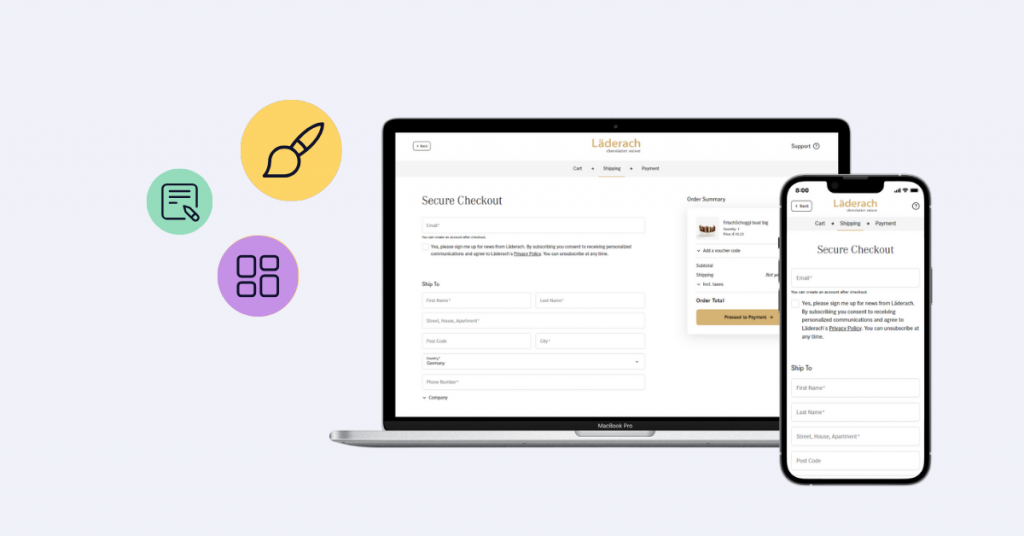
If you want to create a unique, bespoke design for your online store or if you need specific integrations, look for customization abilities. Headless architecture and APIs offer flexibility, letting you tailor your platform exactly how you want it across all channels.
For example, a clothing brand can create a visually rich eCommerce website, a swipe-friendly mobile app, and interactive in-store displays that all work together to reinforce the brand’s identity across every touchpoint.
Just keep in mind that customization often requires technical expertise, so assess whether your team can handle it or if you might need outside support.
Integration with existing systems
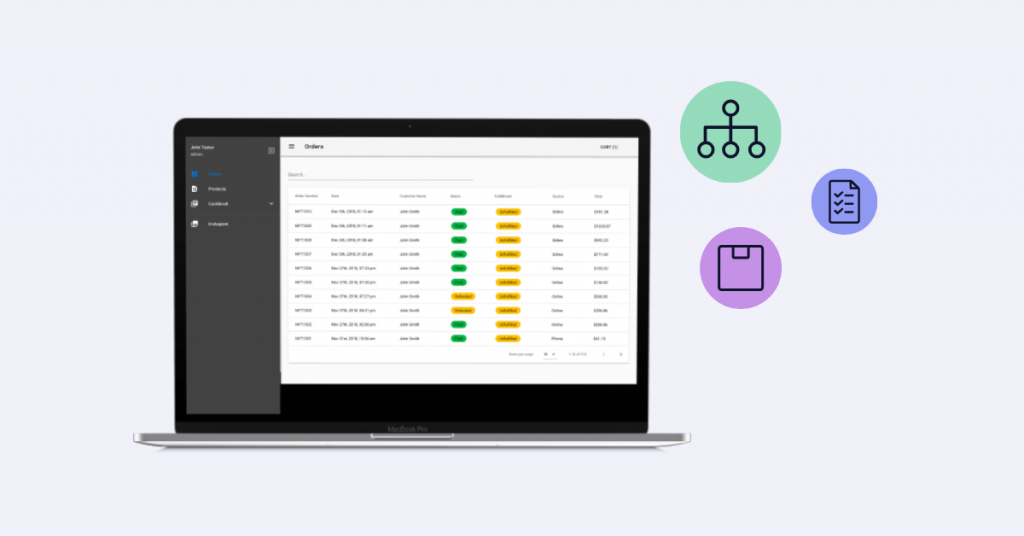
Integrating your eCommerce platform with systems like CRM (customer relationship management) and ERP (enterprise resource planning) is crucial for efficiency. Without solid integration, data silos can form, making it hard to track customer interactions and manage inventory across channels. Besides, an adaptable commerce platform that supports integration with advanced marketing tools is equally important.
Platforms that support APIs and pre-built connectors can ease integration with various systems. However, complex setups might need custom development. Additionally, having an e-commerce platform that integrates with widely used systems like SAP and Microsoft Dynamics can also enhance the user experience and help retain customers via accurate product information and faster order processing.
Security and compliance
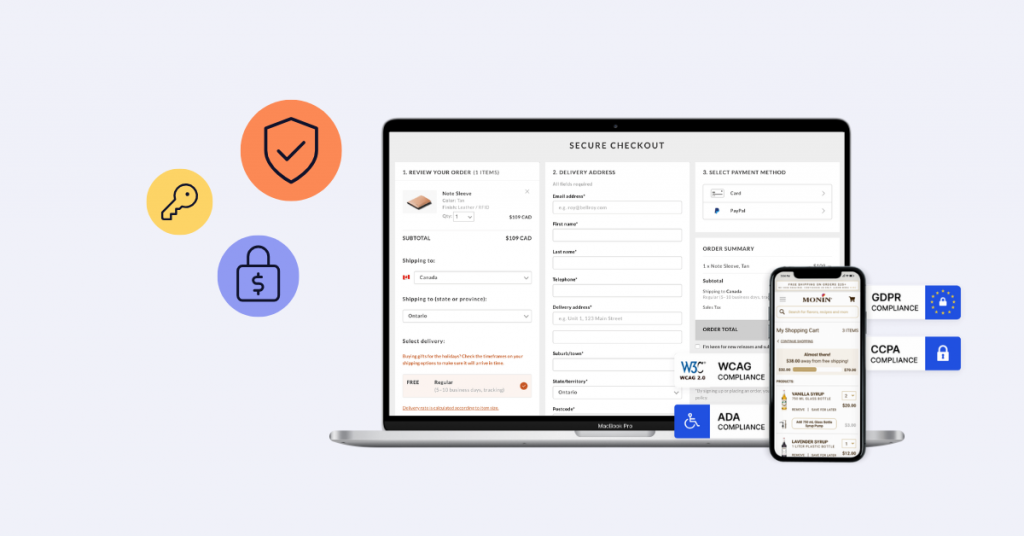
Security is non-negotiable to protect customer data and maintain trust. Most enterprise solutions come with basic security features like PCI-DSS compliance, SSL/TLS encryption, and secure payment processing. But if your business handles a lot of sensitive data or deals with complex transactions, look for advanced options like fraud detection, multifactor authentication, and customizable encryption settings.
Personalization to boost engagement
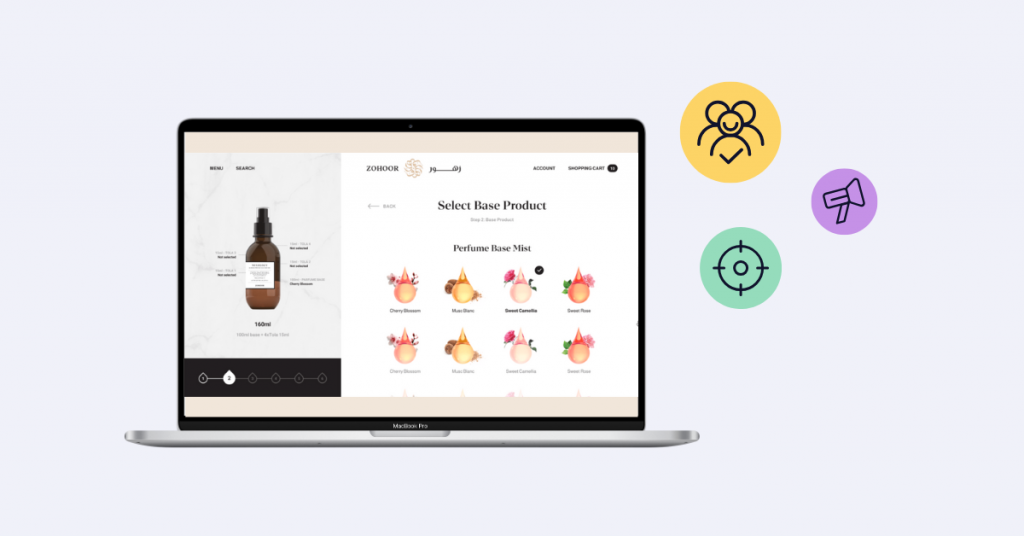
Personalization is key to meeting the needs of your customers and keep them coming for more. Platforms with built-in or integrable AI tools allow you to tailor content, product suggestions, and marketing messages based on customer behavior and preferences. This often leads to higher engagement and conversion rates, besides improving customer satisfaction.
For instance, with dynamic product recommendations, a returning customer might see items related to past purchases, increasing the chances they’ll make another purchase.
Internationalization for global reach

If you are aiming to expand into new markets, internationalization features are a must. These allow your platform to adapt to different languages, currencies, tax rules, and regional preferences, making shopping easy for customers worldwide.
Platforms that handle internationalization (e.g. HCL Commerce) offer options like geolocation-based settings and localized content. Just remember that global expansion will likely require resources for translations, currency updates, and regional tweaks. API-driven and headless platforms are particularly well-suited for this.
SEO (Search Engine Optimization) for organic traffic
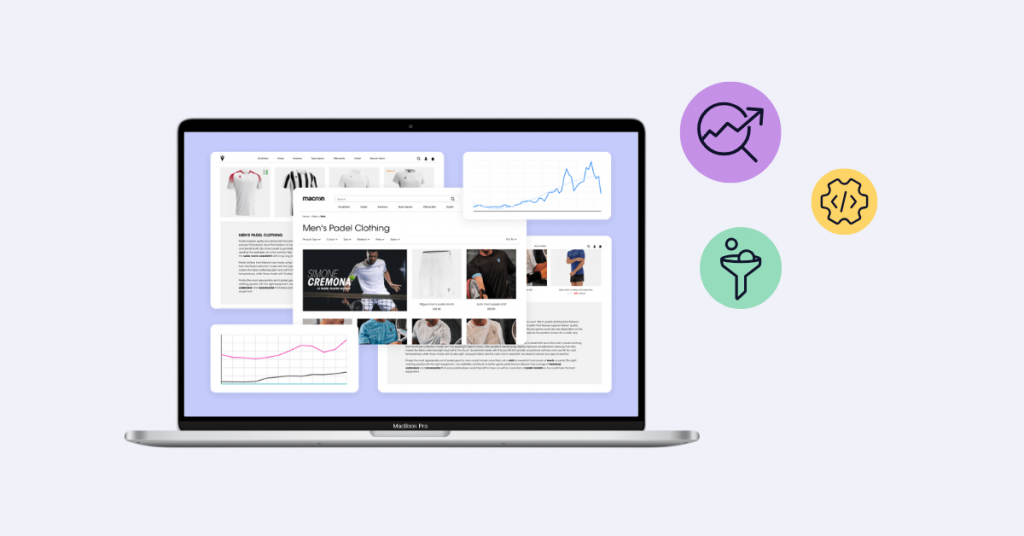
For eCommerce businesses, organic traffic is precious, and SEO plays a big role in capturing it. An SEO-friendly platform should allow for customizable URLs, meta tags, alt text for images, and fast page load speeds to enhance rankings.
Choose a platform that gives you control over things like clear URLs, sitemaps, and mobile responsiveness. Many sites come with built-in or integrable SEO tools, but remember that effective SEO also requires regular updates and content optimization.
Mobile optimization
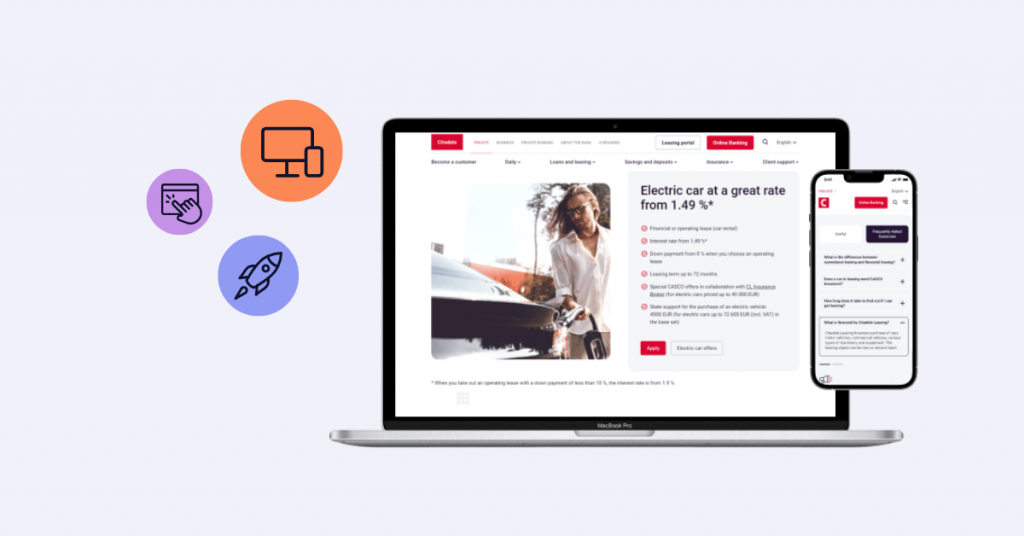
With the majority of users now shopping on mobile, a platform optimized for mobile is non-negotiable. Mobile optimization means your eCommerce site should load quickly, look good, and be easy to use on any device.
Seek platforms that offer responsive themes and mobile-friendly layouts by default. However, mobile optimization isn’t just about design—it also involves mobile-optimized checkout and fast loading speeds, which may require some technical tweaks for best performance across devices.
Analytics and reporting tools
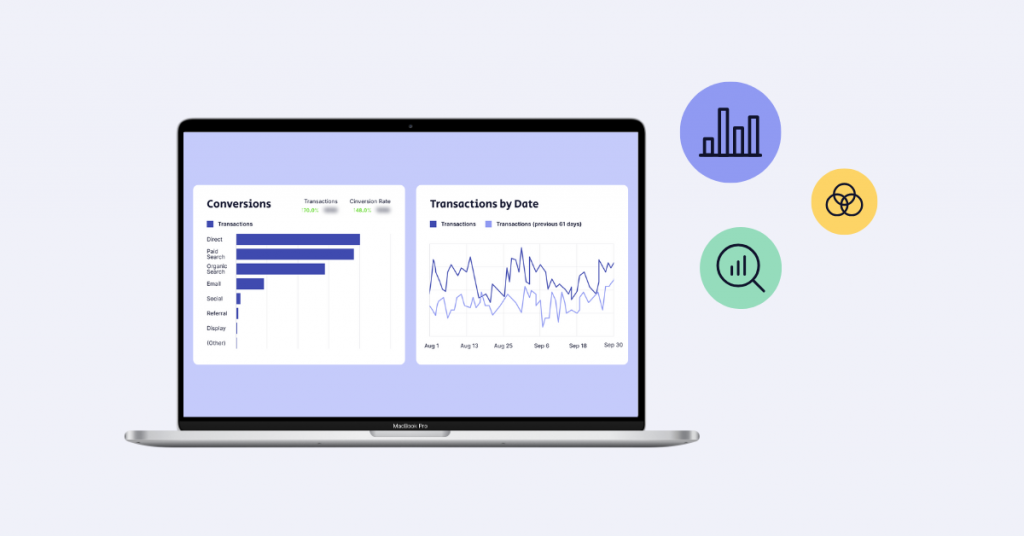
If you can’t measure it, you can’t improve it. Your eCommerce platform should provide analytics tools to track performance, understand customer behavior, and make smart, data-driven decisions. Look for insights into metrics like conversion rates, average order value, and customer lifetime value, as well as channel-specific performance.
Advanced analytics may require integration with additional business intelligence platforms, besides technical expertise. If you don’t have a data-savvy team, consider whether outsourcing this aspect will better support your goals.
Support and customer service
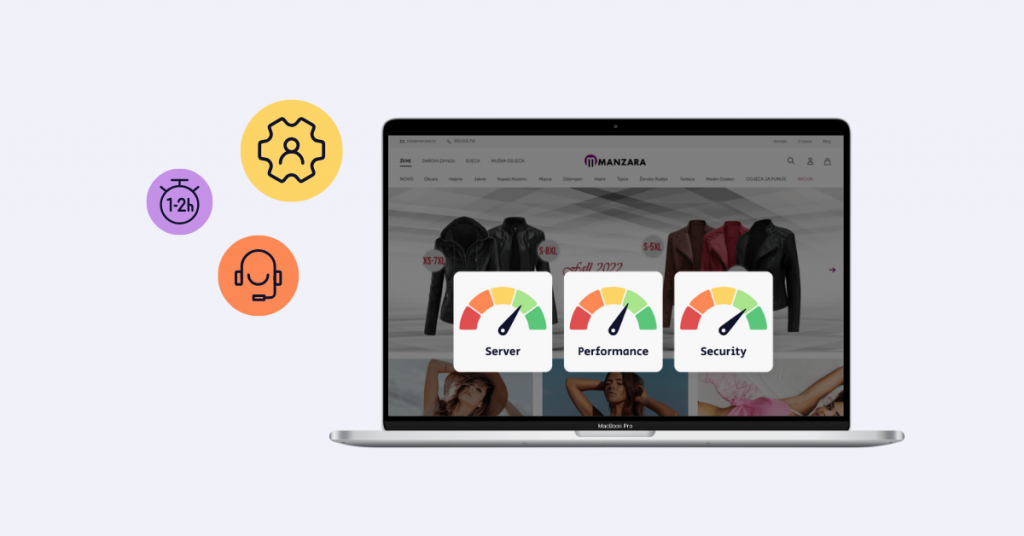
Solid support and customer service are must-haves. Fast, reliable support keeps technical issues in check, reducing downtime and boosting customer satisfaction. Quality customer service plays a big role in user loyalty, so it’s ideal to have quick, multichannel support options (like chat, email, and phone) for both customer-facing and admin needs.
Support quality and costs vary by platform. Some platforms offer premium support plans for a fee, so consider your needs and if the support offered will meet your growth plans.
Costs and pricing
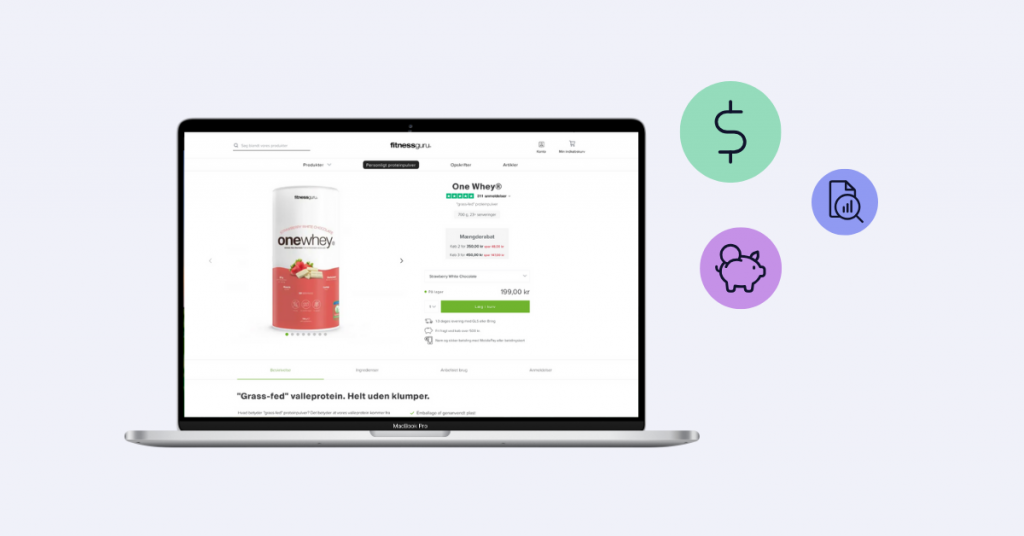
Pricing is a big deal, obviously. Enterprise platforms come with substantial costs—everything from licensing fees and development expenses to integrations and maintenance. Plus, pricing structures can vary widely: some platforms have flat rates, while others charge based on factors like gross merchandise volume (GMV), monthly fees, or even the number of developer seats.
For example, Salesforce Commerce Cloud and commercetools charge based on GMV, meaning costs increase with revenue. Shopify Plus, however, uses a flat-rate model, but high transaction volumes can add extra fees. Make sure the platform’s pricing works with your budget and growth plans, factoring in both setup and potential ongoing costs.
Top enterprise eCommerce platforms comparison
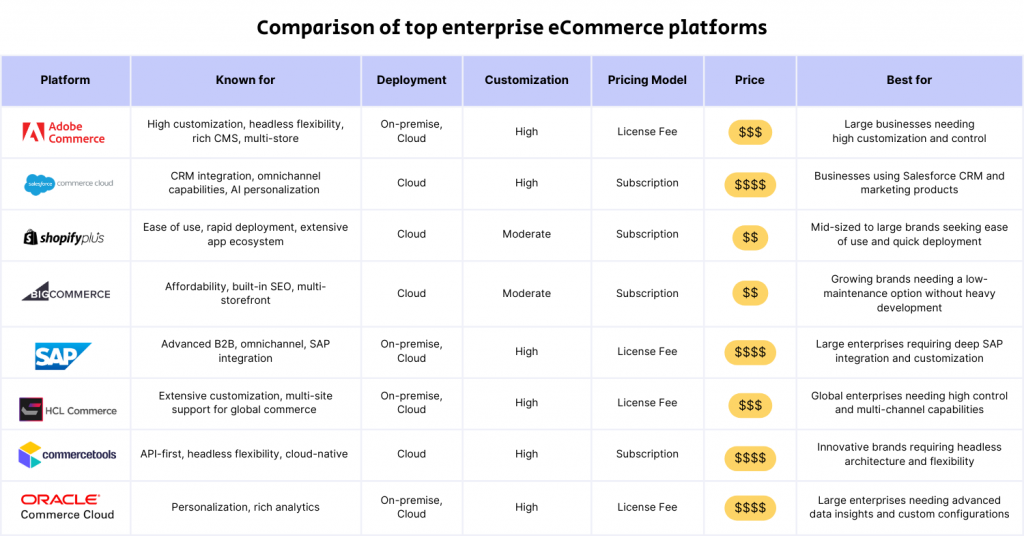
Most enterprise eCommerce platforms offer essentials like scalability, security, and support for complex operations, making them well-suited for large-scale, high-traffic businesses. But they vary when it comes to customization, integrations, and pricing. The right choice ultimately depends on your business goals and priorities.

Adobe Commerce
- High customization and headless flexibility
- Rich CMS and multi-store support
- On-premise and cloud deployment options
- Ideal for large businesses needing extensive control
- License fee model; premium pricing

Salesforce Commerce Cloud
- Deep CRM integration with Salesforce ecosystem
- Omnichannel capabilities with AI-driven personalization
- Cloud deployment
- Suited for businesses already using Salesforce tools
- Subscription model; high-end pricing

Shopify Plus
- User-friendly interface with quick deployment
- Extensive app ecosystem
- Cloud-based with moderate customization
- Great for mid-sized to large brands focused on ease of use
- Subscription model; moderate pricing

BigCommerce Enterprise
- Built-in SEO and multi-storefront support
- Affordable and easy to use
- Cloud-based with moderate customization
- Ideal for growing brands with limited development resources
- Subscription model; budget-friendly pricing

SAP Commerce Cloud
- Advanced B2B support with SAP integration
- Omnichannel capabilities
- Available as on-premise or cloud
- Best for large enterprises needing deep SAP connectivity
- License fee model; higher pricing

HCL Commerce
- High customization with multi-site global support
- Suitable for complex, multichannel setups
- On-premise and cloud deployment
- Geared towards global enterprises
- License fee model; premium pricing

commercetools
- API-first and cloud-native with headless architecture for maximum customization
- Great for flexible, multichannel customer experiences
- Fully cloud-based
- Targeted at innovative brands needing customization
- Subscription model; higher-end pricing

Oracle Commerce Cloud
- Rich personalization and detailed analytics
- Supports complex data insights and configurations
- On-premise and cloud deployment
- Designed for large businesses needing advanced analytics
- License fee model; premium pricing
To get a clearer picture of how each platform fits your business needs and technical landscape, consider consulting with an eCommerce expert or exploring demos.
Case studies: How choosing the best platform supports business growth
PUMA’s transformation with Adobe Commerce and ScandiPWA
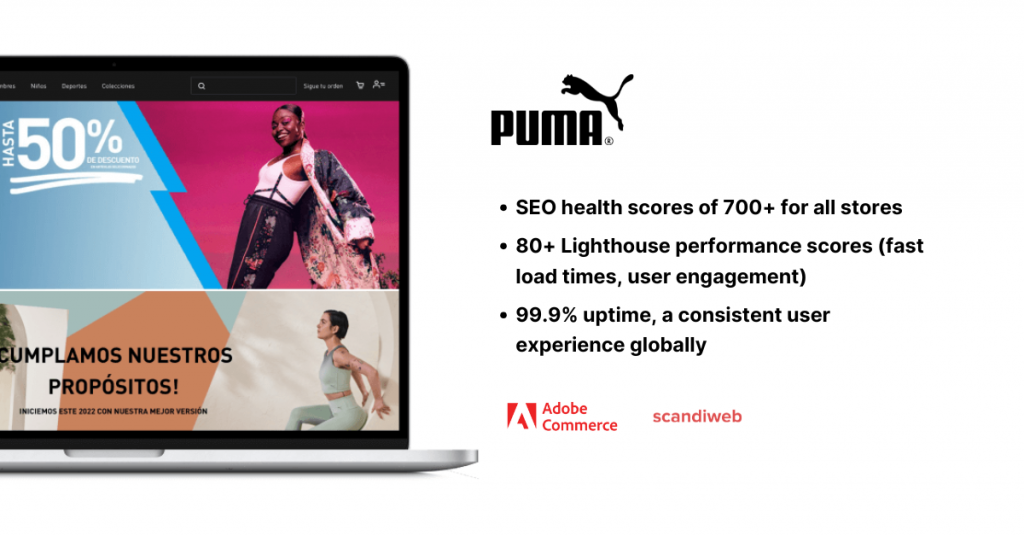
PUMA needed high-performance, feature-rich eCommerce stores customized for various regions, all integrated with their existing global tech infrastructure. They required a scalable solution that could deliver an excellent user experience and meet specific regulatory standards in each market.
scandiweb collaborated with PUMA to develop Adobe Commerce-based Progressive Web App (PWA) stores using ScandiPWA. This approach allowed for quick deployment, regional customizations, and a strong SEO foundation to boost organic growth. Key results included:
- 95 days from project sign-off to launch
- First orders received within 2 minutes post-launch
- SEO health scores of 700+ on ContentKing’s 1000-point scale for all stores
- 80+ Lighthouse performance scores, ensuring fast load times and user engagement
- 99.9% uptime, ensuring a consistent user experience globally.
The New York Times store revamp with Shopify Plus
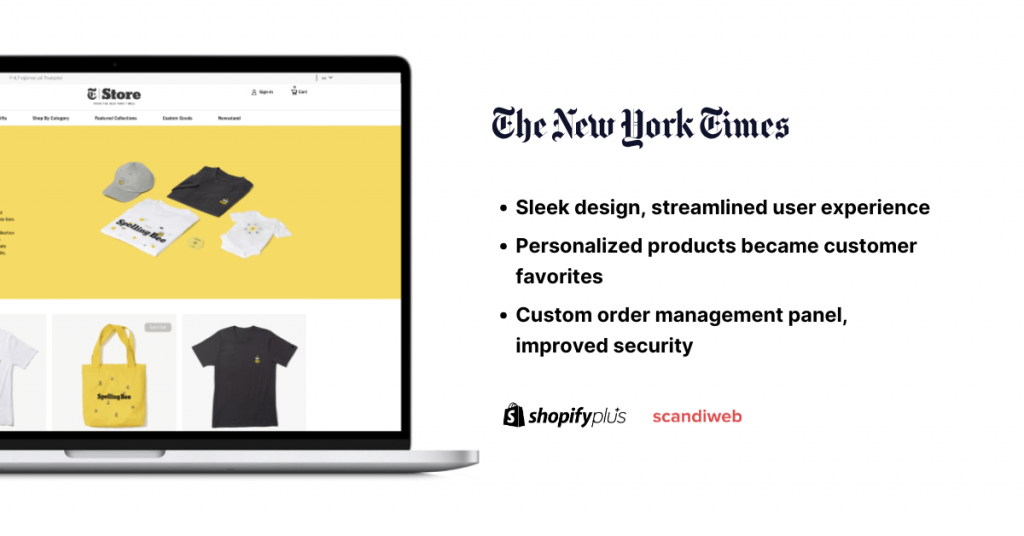
The New York Times needed a refreshed online store that prioritized user experience, enabling customers to personalize products with ease while supporting efficient order management. With Black Friday approaching, they required a solution that would integrate custom product attributes, personalization options, and a custom order management panel for customer service.
scandiweb implemented a Shopify store upgrade for The New York Times, adding custom product attributes and a dedicated order management panel. The agile team of tech, analytics, UX, and SEO specialists coordinated with five client departments to ensure seamless integration and a modernized user experience. Key results included:
- Launched a new store with a focus on modern, streamlined user experience
- Enabled personalized products like reprinted front pages and custom cooking books, making them customer favorites
- Provided a dedicated order management panel for efficient handling by customer service agents
- Facilitated quick onboarding for agents by limiting access to the full Shopify admin, enhancing security and training.
Digilent’s site update on BigCommerce
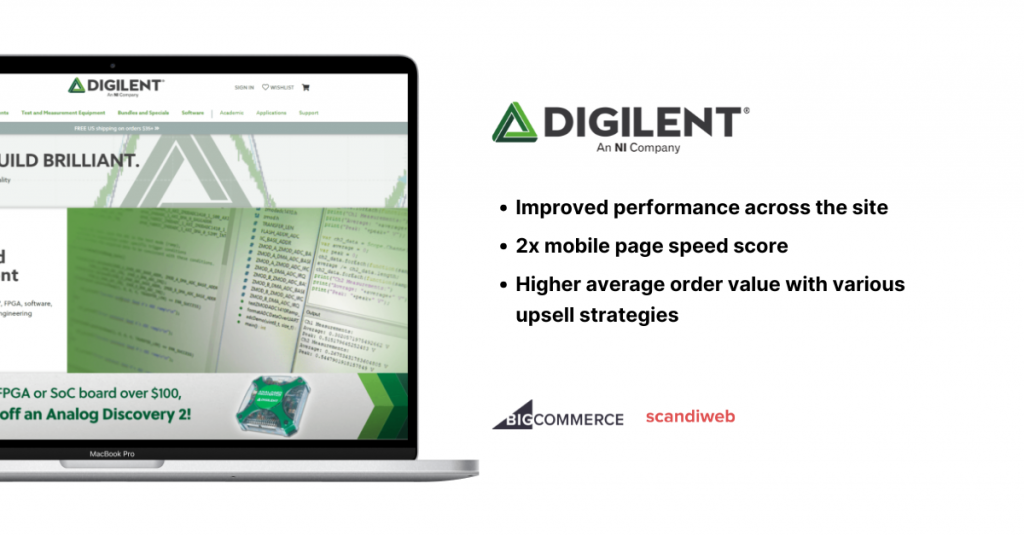
Digilent, a leader in customizable hardware and software for engineers and researchers, aimed to enhance their D2C website performance and user experience. They needed a solution that optimized site speed, improved backend structure, and supported a unified platform for their brand.
scandiweb partnered with Digilent to upgrade their BigCommerce platform, enhance backend performance, and implement CRO strategies for increased engagement. Key results included:
- Backend optimization resulted in improved performance across the site
- 2x mobile page speed score, enhancing mobile user experience
- Upsell strategies with product bundles and cart popups boosted average order value
- Google Analytics 4 integration with Tag Rocket provided enriched eCommerce tracking data.
Future-proofing your choice with emerging eCommerce trends for enterprises

AI-driven personalization
AI is reshaping eCommerce by making personalization smarter and faster. Imagine a system that predicts what each shopper will like based on their browsing, purchase history, and even time of day. For enterprise businesses, AI-driven personalization can strengthen customer loyalty and lift conversion rates by tailoring the experience in real time. Integrating AI tools or working with platforms that offer built-in AI can help deliver customized product recommendations, content, and promotions automatically, which makes the shopping journey feel personal and relevant.
Omnichannel integration
Today’s customers want a smooth, connected experience across all touchpoints—whether they’re on a website, mobile app, or in-store. Omnichannel integration lets businesses connect these channels, providing a unified experience that follows the customer wherever they go. For example, a shopper can browse on their phone, save items in a cart, and later complete the purchase on a desktop or in-store with no interruption. Platforms with strong omnichannel support, especially those that use headless commerce, can simplify this process by syncing inventory, pricing, and customer data across channels seamlessly.
Conversational commerce and chatbots
Conversational commerce uses chatbots and messaging to make shopping feel interactive and personal. With chatbots, customers can get quick answers, product recommendations, and even help with checkout in real-time. This not only improves customer satisfaction but also reduces support costs for large enterprises handling high traffic. AI-driven chatbots allow businesses to provide 24/7 support, helping turn casual browsers into buyers by delivering a more personalized and convenient shopping experience.
AR and VR for enhanced product visualization
Augmented reality (AR) and virtual reality (VR) are changing how customers engage with products online. Imagine being able to see how a new couch would look in your living room, or view shoes from every angle before you buy. AR and VR help customers feel more confident in their choices and can even cut down on returns—a win for enterprise retailers with large product ranges. Using a platform that supports AR/VR can add a new layer of engagement, giving customers a near in-person experience from wherever they are.
A step-by-step guide to choosing the right enterprise eCommerce platform

Choosing the right enterprise eCommerce platform is key to setting up a proper foundation for growth and ensuring smooth operations. Here’s a straightforward step-by-step plan to guide you through the selection process and make sure all essential bases are covered:
- Clarify primary objectives (e.g., international growth, mobile sales) to ensure the platform aligns with key business outcomes
- Involve teams across IT, marketing, and operations for insights on specific platform needs and impacts on workflows
- Identify essential features (e.g., multichannel, inventory syncing) and “nice-to-have” features
- Assess necessary integrations (CRM, ERP) and flexibility for adding new tools as your business needs grow
- Consider technical and operational scalability for traffic surges, larger catalogs, and operational demands like new markets or complex logistics
- Engage your team in hands-on testing with demos and trials
- Review total costs (licensing, maintenance) and project ROI to verify the platform’s long-term financial viability.
Migrating to another eCommerce platform: Tips and best practices
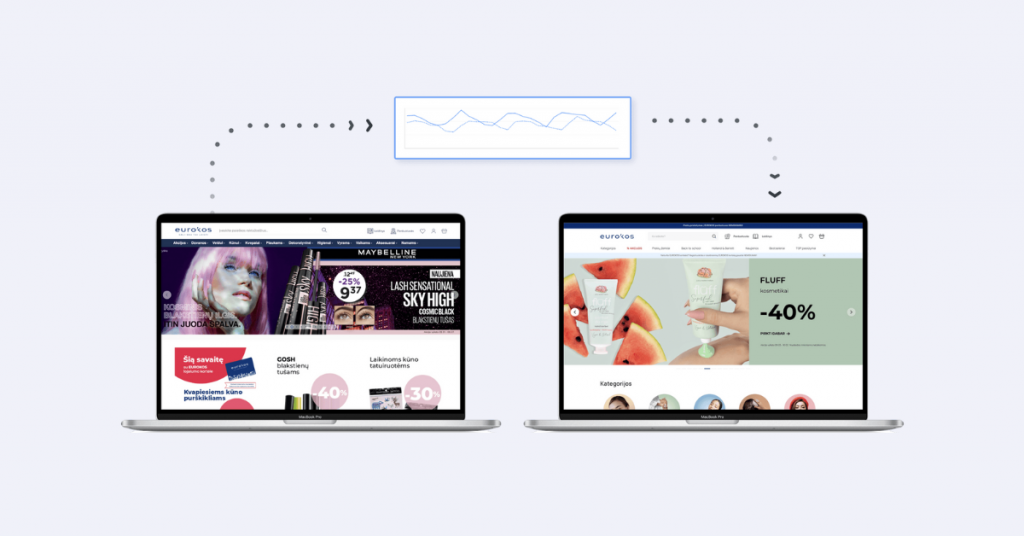
If you’re ready to migrate to a new eCommerce platform, careful planning and a structured approach will make the process smoother.
Start by assessing what’s working in your current setup and where you need improvements—list out must-have features and specific goals, whether it’s boosting site performance or enhancing integrations. A clear timeline with milestones can help you stay on track, and getting input from your team early on will ensure you’re covering all key priorities.
Data migration is critical, so identify essential data to transfer, like customer profiles and transaction history, and back it up first. Use data mapping to ensure accurate movement between systems, and test in phases, starting with small data sets in a sandbox environment to catch issues before going live.
Once the migration is complete, train each team on the platform’s tools, from IT to customer service. Setting up ongoing support—whether through an in-house team or an external vendor—will keep operations running smoothly and help you continue adapting the platform as you grow.
Conclusion: Making the right choice for the best eCommerce platform
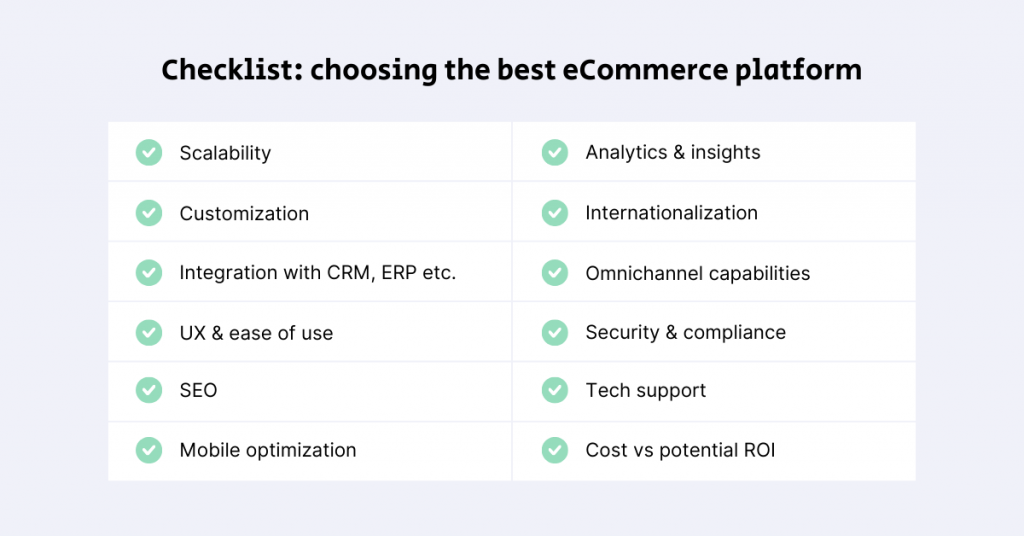
Choosing the right enterprise eCommerce platform is a big decision; it sets the foundation for your business future. With the stakes high, it’s essential to go beyond basic features and consider how each option matches up with your business goals, future growth, and unique needs.
As you evaluate your options, here’s a quick checklist to help you evaluate your options and see which platform fits best:
- Can it support our current needs and future growth, handling peak traffic and larger product catalogs?
- Can the platform be adapted to match our brand and unique needs?
- How well does it integrate with essential systems (CRM, ERP, marketing tools)?
- Is it user-friendly for our team members, with solid documentation and support?
- Does it support responsive design and SEO tools to boost visibility and performance?
- How does it support mobile optimization?
- Does it offer comprehensive reporting for tracking performance, and does it integrate with external analytics?
- Can it handle multiple languages and currencies, supporting a seamless omnichannel experience?
- What are the omnichannel capabilities?
- Are there reliable security features and regular updates to ensure compliance with regulations?
- Is the support responsive enough to resolve critical issues quickly?
- What are the initial and ongoing costs, and does the expected ROI align with our financial goals?
Exploring case studies, consulting with eCommerce experts, and trying demos can really help clarify what each option offers.
With a solid plan and focus on what matters most, you’ll be ready to choose a platform that not only meets your needs now, but also powers your business’s growth and innovation well into the future.
Frequently Asked Questions
What should I start with before choosing an eCommerce platform?
Start by defining your business goals, target audience, and any unique needs, such as required integrations or regional support. This foundation helps you assess platforms based on your specific requirements.
What are the different types of eCommerce platforms available?
The main types include SaaS (e.g., Shopify Plus), PaaS (e.g., Salesforce Commerce Cloud), self-hosted (e.g., Adobe Commerce), and headless commerce platforms (e.g., commercetools).
What essential features should I look for in an eCommerce platform?
Look for scalability, robust security, customization options, integration capabilities, SEO and mobile optimization, and solid support services to meet current and future business needs.
How can I ensure the chosen platform is compatible with my existing systems?
Check for API compatibility and pre-built integrations with your essential tools, like CRM and ERP. Testing integrations during trials can also verify seamless connectivity with your systems.
What should I consider when planning a migration to a new eCommerce platform?
Plan for data migration, testing, team training, and maintaining SEO. A structured approach ensures a smooth transition with minimal disruption to your business operations.
Explore our popular eCommerce services
Can’t decide which is the right eCommerce platform for growing your online store? Reach out to us for your personalized consultation on how to elevate your business online! Let’s achieve success together!
About scandiweb
scandiweb is an eCommerce agency specializing in development, migration, optimization, and more. With expertise across platforms like Magento, Shopify Plus, BigCommerce, and commercetools, scandiweb helps businesses grow, scale, and improve revenue through tailored solutions. Trusted by global brands, we focus on driving digital success with innovative strategies and a customer-centric approach.
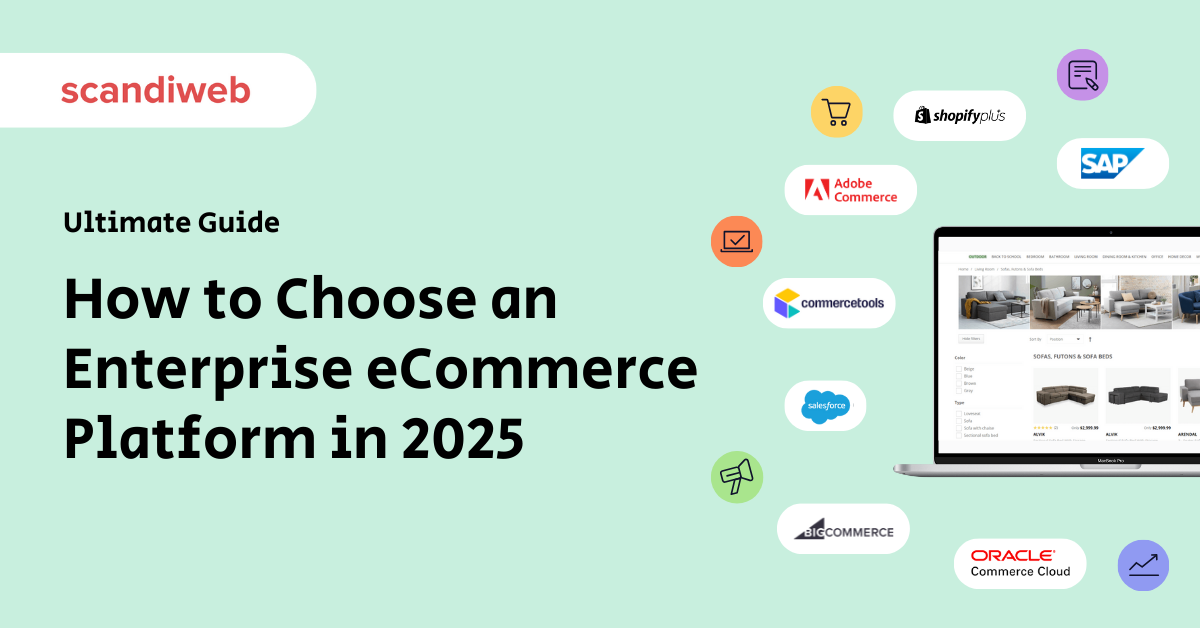

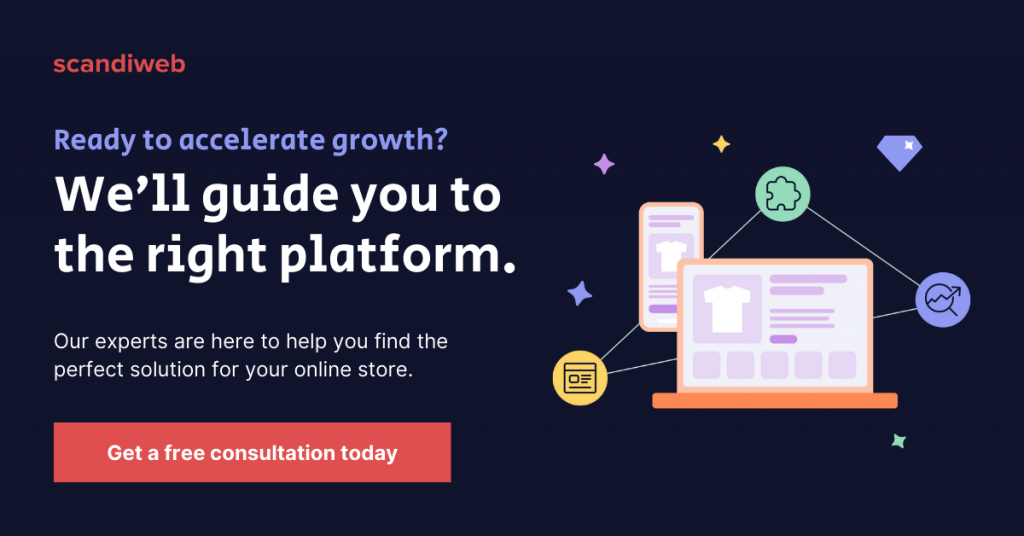

Share on: